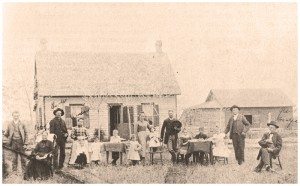French—Canadians were among the earliest settlers of the Campbell area. The Desire Genereux and Joseph LaPorte families arrived in 1874 and, within less than 10 years (1883), according to St. Ann’s Catholic Church census, there were 35 families of French decent living in the immediate area. In addition to the familiar family names – Brouillette, Brule, Boudreau, Breault, Chagnon, Champoux, Chevalier, DeMars, Forest, Gagnon, Genereux, LaPorte Mercier, Marcille and Roulier – there are less known families – Carpentier, Houle, Lefort, Lym-borner, Messier, Moreau, Paradis, Proulux, Sabourin and Verville. This migration continued into the 1890’s as other families such as, Beauchane, Bourdeau, Chavelin, LeBeault, Lavoie, Gaudreault, and others joined the community. Some of these families left the area, a few returned to Canada, but many remained. Although dwindling in numbers, many present members of the Campbell and Hastings communities trace their lineage back to these early French-Canadian settlers.
Many of the French-Canadians secured land in the western half of Harmony Township in Webster Co., while others located directly north or to the southwest of the present site of Campbell in North Franklin Township, Franklin County.
They established the first Catholic Church in 1880 (See history of St. Ann’s Church) and, with the exception of a few German and Irish families, the congregation was French.
In the late seventies and eighties, other French-Canadians settled southwest in Buffalo Township and Logan Township (now N. Marian Twp.) in Franklin Co. These families – Benjamin, Berger, Boutin, Gangner, Choquette, Delhute, LeBlanc, Petro, Quinton, Soucie, Thibodeau and Trambly -also established a small church in 1884 and named it in honor of St. John the Baptist. This was a misson of St. Ann’s of Campbell and was in existence less than four years. The church was auctioned off in January, 1889 and attempts to build a larger church failed as many of the parishioners purchased land closer to Campbell, left the area, or set up businesses in Campbell.
Most of these families were descendants of the French who came to the New World between 1608 and 1756 and settled in what later became the Province of Quebec, Canada. Although the vast area surrounding the Gulf of St. Lawrence and the Gaspe peninsula was claimed for France by Jacques Cartier in 1534, the French government did little to colonize this territory until the 1600’s.
Samuel de Champlain, a French explorer and fur trader, helped to establish the small colony of Acadia (now Nova Scotia) and four years later (1608) founded the city of Quebec, which was the first permanent settlement in what is now Canada. French fisherman fished off the eastern coast of the peninsula and went ashore to dry their catches. They developed a good relationship with the Indians and soon established a lucrative fur-trading business by exchanging fish for the Indians’ furs. French merchants offered to help the king establish colonies in the “New France” in return for fur-trading rights. Numerous French fur-trading companies were form¬ed and hundreds of French settlers followed.
The French were staunch Catholics and welcomed the establishment of the first missionary center located on the island where the St. Lawrence and Ottawa rivers meet. Founded in 1642 by the Society of Notre Dame and named Ville-Marie, the colony grew and prospered and today is the city of Montreal, the largest city in Canada.
During these formative years, the French government sent a large military force to keep the peace and rule the colonies, but, by 1663, “New France” had grown to such an extent that Louis XIV made Canada a province of France. Although both the governor and the intendant, were appointed by the king, the colonists sent representatives to the Sovereign Council, which served as the court, legislature, and administration of the government.
…..
Most of the French-Canadians, who migrated to this area, were from the small villages that surround Montreal. Although many came here directly from Canada, several had spent a few years in the border States, such as, Illinois and Indiana before coming to Nebraska.
They spoke very little English and their language was so different from Parisian French that it was almost a separate language. United by a common language and religion, the growing French-Canadian community was often criticized as being aloof. In time, this changed as many of them left their farms to become merchants in the newly-formed town of Campbell.
The French brought with them many age-old traditions which were often continued into the second and third generations.

